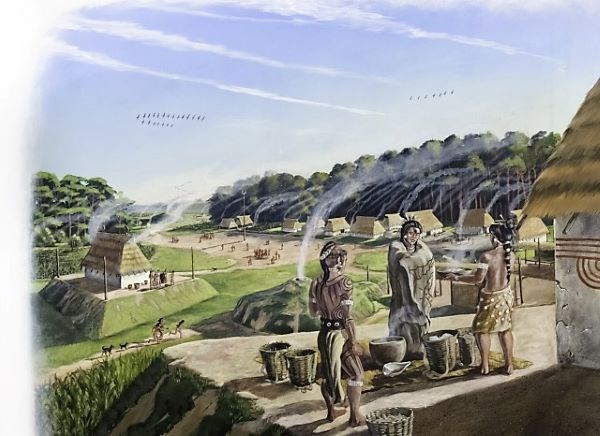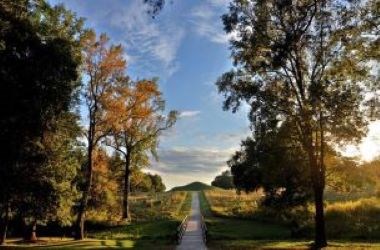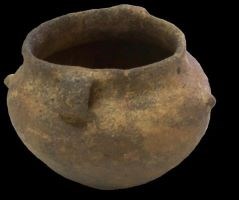
Dean Quigley The Mississippians constructed a large ceremonial complex and town on the Macon Plateau near the Ocmulgee River at present-day Macon, Georgia. They left no written records, but archaeologists excavated an abundant collection of artifacts that help explain the life and culture of this society. The ceremonial complex, still visible today, is only a portion of the “Macon Plateau” culture. Six miles away the Early Mississippians built another large village, and several smaller sites once existed near the Ocmulgee River’s Fall Line, where the natural resources of the hilly Piedmont and flatter Coastal Plain overlap. Mounds and Buildings Earth mounds represent the most visible, and for some people the most intriguing, evidence of the Mississippian culture. The mounds served various purposes including acting as massive platforms. The platform mounds tended to be flat-topped pyramidal structures with ramps for easier access to the summit. Wooden buildings atop the mounds functioned as homes, temples, storage facilities, etc. Most of the mounds in the Ocmulgee complex were created in stages, increasing the size of the mounds over years of occupation. 
NPS Community The extensive mound construction suggests that the Mississippians had a complex social structure. A strong leader would be necessary in order to carry out the planning and execution of building projects. The prominence of the temple mound also implies a strong religious component to the society. Some archaeologists speculate that Mississippian society was organized into “chiefdoms”, which consisted of several towns. Each town had a chief, perhaps subservient to a more powerful Priest-Chief. The people of the Macon Plateau town were sedentary farmers. They carried out extensive cultivation using tools of wood, bone and stone. Major crops included squash, pumpkins, sunflowers, and tobacco, but predominantly corn and beans. They stored excess food in baskets and pottery, and the surplus allowed them to devote time to other aspects of life. The Mississippians hunted to supplement their diet, concentrating on small game such as raccoon, turkey, rabbit, beaver, squirrel, turtles, and deer. No part of the animal would be wasted – skins were tanned to make clothing, bone became jewelry, fishhooks, and projectile points. Hunters used several techniques to find game, but the bow and arrow was essential for a successful hunt. 
NPS The art of the Mississippians can be seen in the items of everyday life. Women constructed pots by coiling and modeling local clays. The early Mississippian pottery was made in many sizes and shapes suited to a variety of everyday and ceremonial uses. They preferred plain surfaces, but the elegant and sometimes complex forms of the pottery reveal skill and beauty. Occasionally effigies decorated the pots. Women wove baskets and fabrics as well, personalizing them with various designs. Mississippians also found the time to make objects with which to adorn themselves. Stone, wood, bone, shell and other materials were probably utilized, but unfortunately, organic material does not survive well in the moist, acidic soil of the southeast. Based on evidence from other archaeology sites and upon historic accounts of the Native Americans, people decorated themselves with shell gorgets, beads, tattooing, paint, elaborate hairdos, feathers and many types of ear ornaments. One of the games Mississippians played was called “Chunkey.” A player rolled a disc-shaped stone across the ground while other players threw their spears at it. The player whose spear landed closest to where the disc stopped became the winner. The Mississippians also played a ball game very similar to the modern game of lacrosse. Two opposing teams used wooden racquets to throw a small leather ball down a large playing field and tried to score by tossing the ball between two vertical posts at each end of the field. The ball game was usually played between two rival towns and sometimes was a method of settling arguments. By 1200, the town on the Macon Plateau was no longer a center of Mississippian culture. The people may have migrated elsewhere or have been assimilated by those who originally inhabited the area. Mississippian culture continued to thrive at places like Etowah in Northern Georgia, Moundville in Alabama, and Spiro, Oklahoma. By 1350, a late Mississippian town was established about 2 ½ miles down the Ocmulgee River from the Macon Plateau at a site known today as Lamar. The inhabitants built two earthen mounds, one encircled by a unique spiral ramp, the only one of its kind still known to exist in this country. The site lends its name to a widespread late Mississippian southeastern culture, and is also protected as a separate unit of Ocmulgee Mounds National Historical Park. |
Last updated: July 26, 2023
